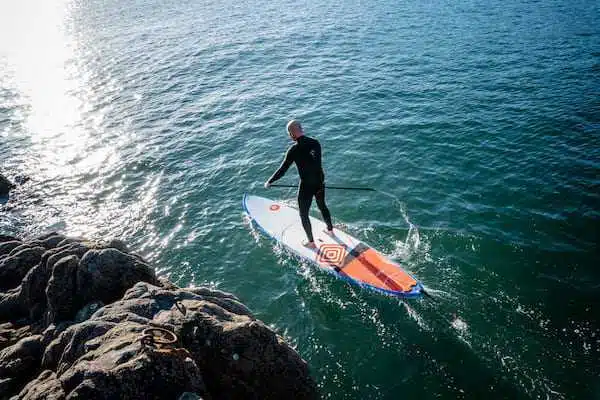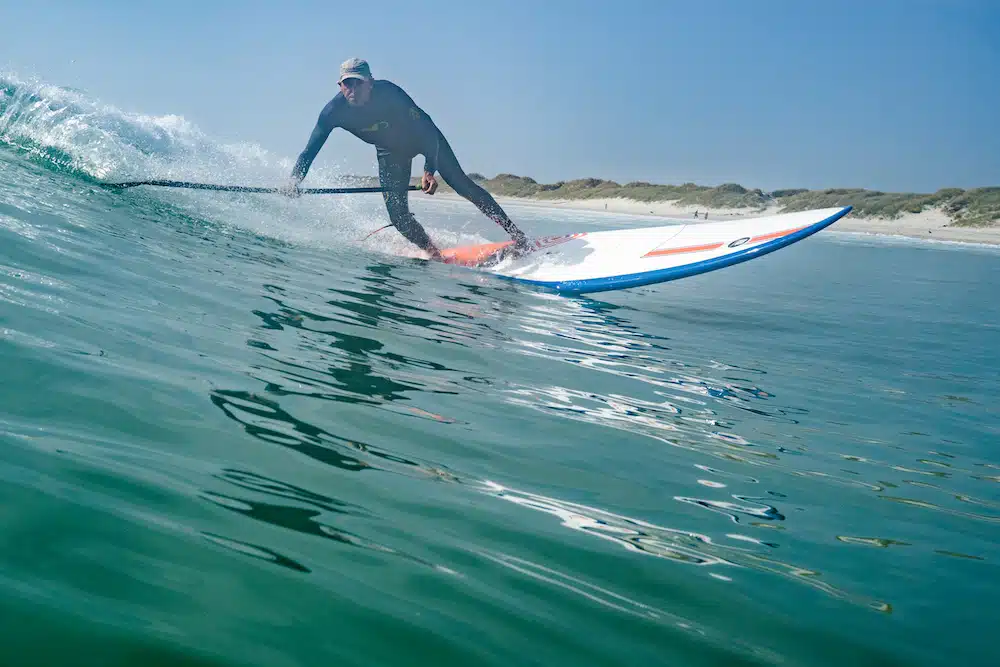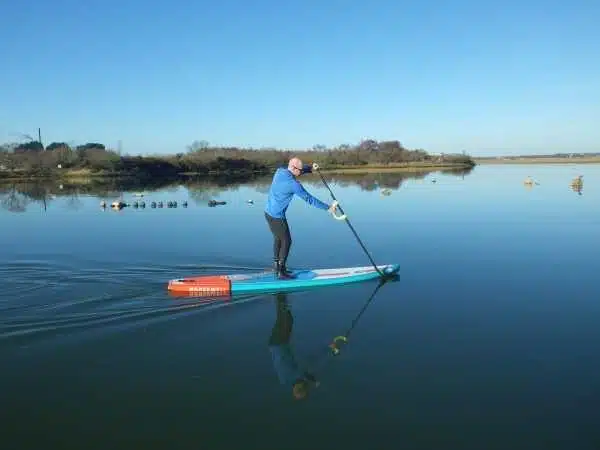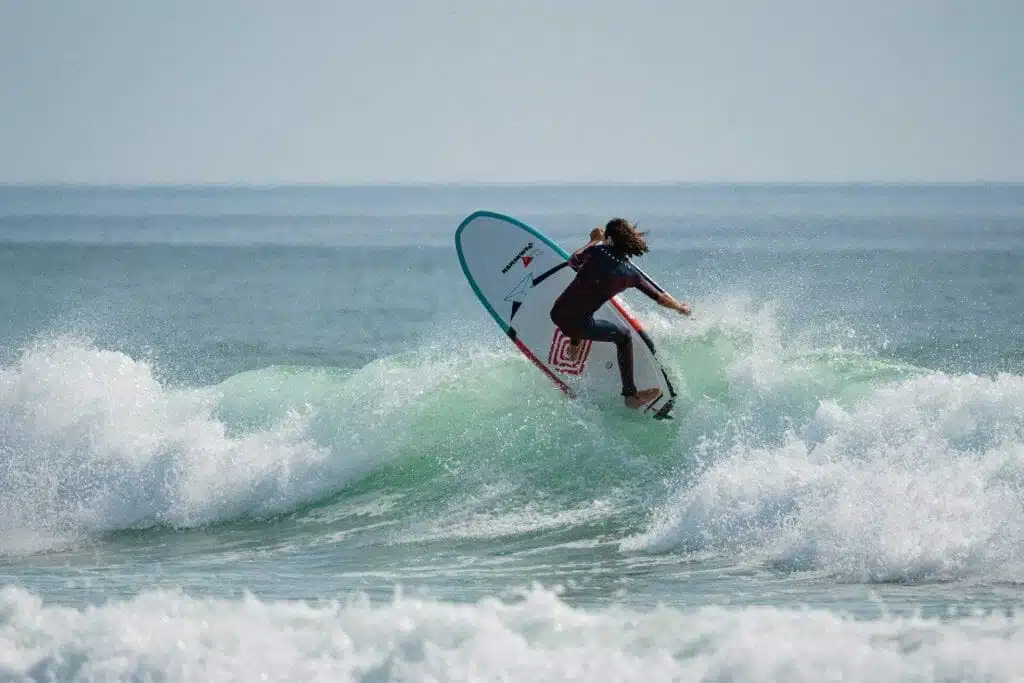Paddle has established itself as the trendy outdoor sport, accessible to beginners and experts alike. We give you our professional opinion on the right stand-up paddle equipment to choose, the right prices and also on spots, accessories and paddles!

Firstly, stand-up paddling is a super all-round water sport. Generally speaking, it not only gets your cardio going, but also your upper body, legs and abdominal muscles. It’s also the perfect way to improve your balance!
Secondly, the sup is extremely versatile. Whether you’re going on an adventure or just cruising around with an all-around paddle, competing in races, using it for family outings or even surfing and SUP foiling: everything is possible with this discipline, in all conditions, and that’s what we love about it. So much more than kayaking and canoeing, you can exploit all the best that the sea and whitewater have to offer.
If you’re a beginner and you’ve never really tried water sports before, the first thing to consider is not so much what you do, but what level you’re at. It’s important to choose a board that’s easy to learn. It would be a shame to give up on stand-up paddling as soon as you start out, with equipment that’s too small. Width is particularly important, as it determines your stability.
For the intermediate level, or those who already practice other board sports such as kitesurfing or windsurfing, you can already start to orientate yourself according to your practice (surfing, cruising…) but the best is to orientate yourself towards boards that offer a minimum of versatility and comfort so as not to get into difficulty.
For SUP experts, it’s what you do that defines your needs, and we’ll explain in detail which board is best suited to each activity, so you can get the most out of it!
In general terms, these are the parameters we’ll use to define the SUP’s shape. Note that, for the same level of performance, the bigger your template, the wider and longer you’ll need to make life easier.
The longer your paddle, the more it “glides”. In other words, an oar stroke is more efficient. Length also reduces the phenomenon of “row”. If your sup is very short, it will tend to pivot to the right if you paddle to the left. This is very useful in surfing to be agile on the wave, but less pleasant in competition or over long distances when you want to change sides as little as possible…
It provides comfort and stability. On the other hand, it will make you slower and require more effort to maintain speed. If you’re just starting out, it’s very important to have a consistent width so you don’t get into trouble.
This is even more important for inflatable paddles, which need to have their skins spread apart to guarantee a minimum of rigidity. As you increase the thickness of your paddle, you reduce the feeling of gliding as you move further away from the water. A greater thickness also reduces balance, as you find yourself tossed about like a cork on the water beyond 5 inches.
Pointed noses are ideal for racing or for making a bit of distance, as they make it easy to split the wave. In surfing or for beginners, noses become rounder, losing glide but gaining grip on waves. On rigid paddles, you can also work on the shape of the bow, hull and deck to make them more resistant to chop, for example.
They’re very varied, but to put it simply, the more pinched the tail, the more maneuverability you gain and the more stability you lose. The wider the tail, the less manoeuvrable you are on the wave, but the better your start and the more stable you are.
Combined, these can be used to create sup shapes that are more or less suited to your riding style and level. Here are the main shapes found on the market and available from all brands.
What you need is an intermediate length for versatility (in the 9/11 foot range), a generous, round nose and tail, and above all, good width!

It’s the compromise between wave and promenade. Relatively short, between 9 and 11 feet, it’s often rather wide, with a round nose and a comfortable tail. Ideal for beginners, families and intermediate riders who want to do it all without getting in over their heads.

Longer than the all-around, between 11 and 12 feet with a sharper nose, they often retain a little width. The length allows for longer distances and greater rowing efficiency, while retaining an accessible shape. They are no longer relevant for waves, as they are too long, but remain great in the sea, even with a little chop. The wider models are ideal if you’re just starting out and don’t intend to surf with them. Note that there are even models that can be used as doubles! These ranges are often available on rental sites, so don’t hesitate to consult our network of partners in France to find out more; the adventure may be worth the detour.
Long, often 12’6″ or more, they are also (very) slender, with a pointed nose. If their balance is precarious, they are speed machines, especially on flat spots and long distances. To be reserved for seasoned users.

These are generally the shortest, under 10 feet, with a round nose. Highly maneuverable, they have specific widths and tails for different uses: a very pinched, thin tail for maximum agility to an almost rectangular tail for greater stability and power in soft waves.
| Practical information | ~ 50-60 KG | ~ 70-80 KG | + 90 KG |
|---|---|---|---|
| All round | Length 30′ to 31′ – Width 10′ to 11’6 » | Length 31′ to 32′ – Width 10′ to 11’6 » | Length 32-36′ – Width 10’5 » to 11’6 » |
| Touring / exploring | Length 11’6 » to 12’6 » – width 28′ to 30′ | Length 12’6 » to 14′ – width 29′ to 32′ | Length 12’6 » to 14′ – width 32′ to 34′ |
| Wave practice | ~ 50-60 KG | ~ 70-80 KG | + 90 KG |
|---|---|---|---|
| Beginner | Length8’5 » to 9′ Width 30 » to 31″ | Length 9′ to 10′ Width 31 » to 33″ | Length 10′ to 11′ Width 32″ to 36″ |
| Intermediate | Same size – Volume minimum = your weight + 35 to 40 L | Same size – Volume minimum = your weight + 35 to 40 L | Same size – Volume minimum = your weight + 35 to 40 L |
| Expert | Width 25″ to 28″ Volume = your weight to your weight + 30 L | Width 26″ to 29″ Volume = your weight to your weight + 30 L | Width 28″ to 32″ Volume = your weight to your weight + 30 L |
Safety first! As with most water sports, the leash is essential. It attaches to the back of the tail, on the deck and is worn around the ankle. We recommend the leash coiled – or telephone, which is the most common because it’s more comfortable.
It’s your engine, and it’s essential that this equipment is good. There’s no point riding in a beautiful body if you have to push it by hand! So it’s best to pay the price and enjoy the best of the sport. Originally made of wood, today’s bodies are either aluminum or composite (fiberglass and carbon). Aluminum requires maintenance, and although it’s very shock-resistant, it’s heavy and can’t be repaired if you bend the handle. This material is reserved for schools or the very first prices. We recommend either a mix of fiberglass and carbon, which can be good value for money, or 100% carbon if you use it regularly. Beware, too, of removable oars: the more parts they have, the less stiff they are. If you’re planning to do some wave, downwind or distance rowing, go for a one-piece shaft, possibly with an adjustable olive, but avoid three-piece shafts.
The advantages of a hard surface in terms of feel, longevity and performance are absolutely indisputable, and very quickly outweigh the few disadvantages. If you want to do something else with your equipment, use it on a very limited basis during the season and prioritize quality (because inflatable prices often reach those of hard as soon as a minimum of performance is required, so it’s sometimes better to wait for the right promo…), inflatables may not be the solution, even if it’s common to read the opposite.
The French spots are particularly varied, and it’s common for some of them to be cited as the best in the world!
When it comes to touring, as long as the conditions are right, the choice of scenery is yours. From the Calanques in Marseille to the gorges of the Var, via the Dordogne, Lake Annecy or the Breton coastline, all you have to do is take your equipment with you and enjoy a whole new viewpoint in complete tranquillity.
There are numerous race formats available throughout France. The Tawara (in the Tarn region) and the Dordogne intégales, for example, rub shoulders with races in the Atlantic Ocean, such as the Beach Race in Crozon, or The Race in Guadeloupe.
All the surf spots are waiting for you, from Brittany to the Basque Country. Take advantage of the slightest undulation.
Less common, downwind surfing is emerging in Brittany and the south of France, with foil surfing in full swing.
As we said, the French landscape is as rich as the discipline itself, and it’s this freedom that we love!
Click & Collect
Secure payment in 3 or 4 instalments
Advice from enthusiasts
Satisfied or refunded
2 to 3-year warranty
Worldwide shipping
Foil and Co., All rights are reserved. ©2024